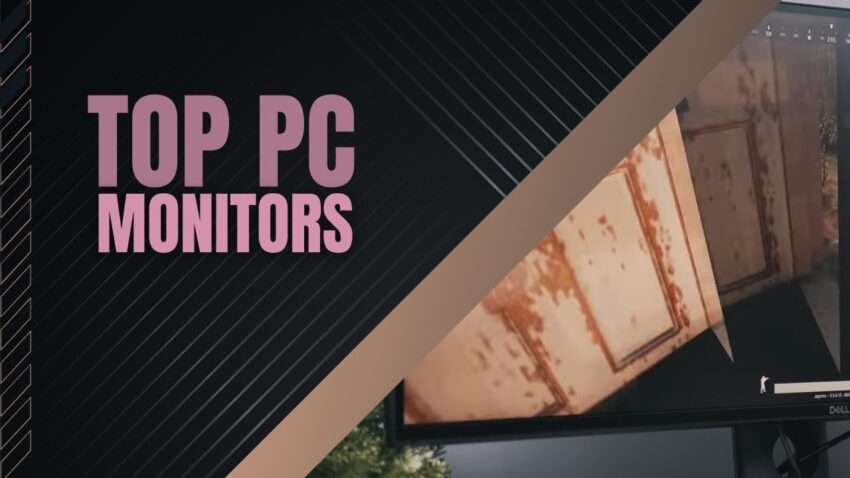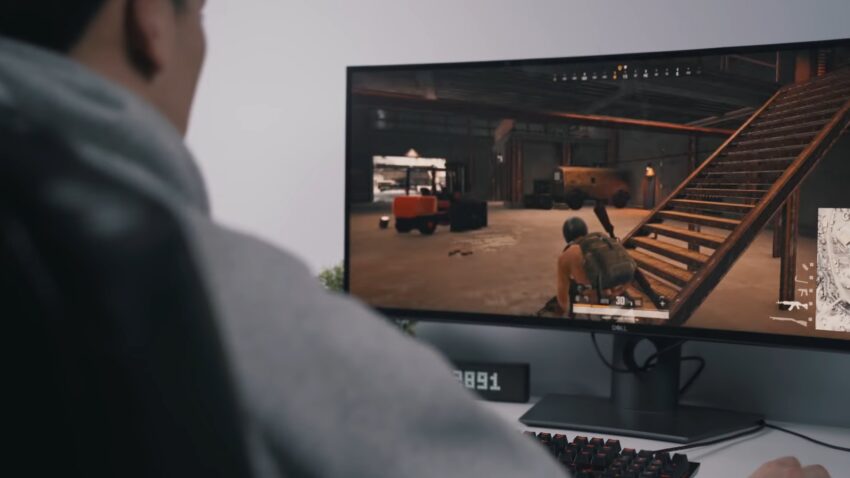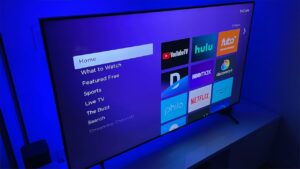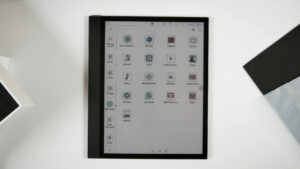It may be difficult to choose a new monitor as it varies significantly in size, shape, and performance. There are various styles of monitors based on the intended use, so there is no catch-all monitor that is suitable for all. Some devices, though, are more powerful than others.
From ultra-wide office monitors to high-performance gaming monitors, there’s something for everyone on this list. Below you’ll find our top picks for the best monitors available for purchase. See also our recommendations on the best gaming monitors, best TV to use as a monitor, best gaming headphones, best soundbars for your TV.
Top Monitors to Upgrade Your Display Game
1. Best Monitor: LG 27UK650-W
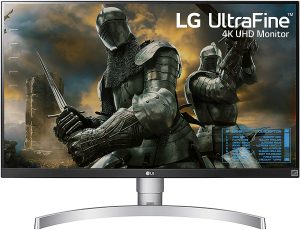
The best monitor we’ve reviewed so far is the LG 27UK650-W. This 27-inch display has a simplistic and stylish design that suits any setting. At a resolution of 4k, it provides accurate pictures, and the text appears amazingly bright.
The refresh rate is restricted to 60Hz, but FreeSync is allowed should you choose to use it for games. The IPS panel has perfect viewing angles, and you can quickly post content or work with others.
This monitor has a perfect out-of-box color accuracy. The SDR color gamut is great, covering nearly half of the sRGB color space, and its Adobe RGB range is strong, which is ideal for advanced picture editing. The input lag is very short and has a fast response time, resulting in a sensitive user interface and reduced motion blur in fast-moving scenes.
This doesn’t have a ton of extra features, but the flicker-free backlight is a good touch if you want to look at the screen for a longer period of time.
Unfortunately, while this monitor supports HDR, it can not view a wide range of colors. Unlike other IPS monitors, it has a very poor contrast ratio that makes blacks appear grey when displayed in the dark.
However, if you’re in a bright place, it’s going to be light enough to battle the glare, because it has a matte finish that handles the reflection decently well. Overall, this is a powerful device that most users will be pleased with, making it the best monitor we’ve seen so far.
- Excellent resolution and size allow for multitasking.
- Input lag is very low.
- Wide viewing angles.
- Lacking HDR performance.
- No local dimming support.
2. LARGER ALTERNATIVE: LG 32UL950-W
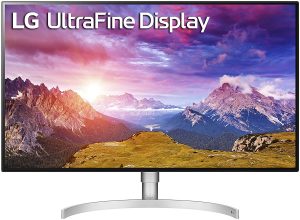
When you need more screen space, then the LG 32UL950-W is a good alternative. The viewing angles are not as strong as those of the LG 27UK650-W, but the two displays work very equally, so choosing one over the other is a question of personal choice. The contrast ratio and black uniformity, while not perfect, are also an upgrade over the smaller LG, and this display is a safer option for dark room viewing.
This displays a wide variety of colors for HDR images, and photographers should be happy with the excellent use of the Adobe RGB color space used in picture editing.
Unfortunately, reflective handling is disappointing, although it does get bright enough to help minimize glare in much of the rooms. If you’re looking for the best monitor, look into the 27UK650-W, but if you want a bigger screen, consider the LG 32UL950-W.
- Doesn’t handle reflections well.
- 60Hz refresh rate is limiting for gaming.
- Doesn’t handle reflections well.
- 60Hz refresh rate is limiting for gaming.
3. Best Gaming Monitor: ASUS VG279QM
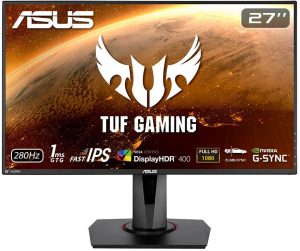
The best gaming monitor we’ve reviewed so far is the ASUS VG279QM. It is a 27-inch IPS panel with a 1080p resolution and a 280Hz refresh rate. The building standard is excellent and has outstanding ergonomics, including portrait rotation and a wide range of swivels.
It’s getting bright enough to remove the glare, but its transparent handling is just good, and it’s better to stop direct sunlight. It’s not as well suited for dark rooms as its poor contrast ratio makes blacks look gray, as is expected with most IPS panels.
In addition to its 280Hz refresh rate, this monitor has a superb response time which results in very little motion blur. The response time doesn’t alter much when you play at 60Hz, making it a decent option for console gamers.
There is also an available black frame placement feature to help enhance motion visibility. This natively supports FreeSync and is also compatible with the NVIDIA G-SYNC. HDR is enabled, but unfortunately, this monitor can not show a large range of colors, even if its HDR peak brightness is good.
This monitor doesn’t deliver much in terms of additional features. You get a USB 3.0 port for charging, and you can install a simulated crosshair, timer, or frame rate monitor on your computer. The backlight is flicker-free to help minimize eye strain and is ideal for long gaming sessions. Ultimately, the 1080p resolution could be a little low for others, particularly if you want to use the display for productivity tasks; but, if gaming is a priority, you can check it out.
- Outstanding response time.
- The image remains accurate at an angle.
- Outstanding ergonomics.
- Low contrast.
- Extremely high input lag at 60Hz.
4. 1440P ALTERNATIVE: ASUS TUF VG27AQ
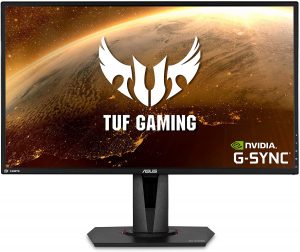
If the 1080p resolution of the ASUS VG279QM is too low for you, then take a look at the ASUS TUF VG27AQ. This display has a 1440p resolution on the same 27-inch panel scale, which results in a far larger pixel density, making text and images much clearer.
There is a touch of a trade-off, though, because the refresh rate on this display is up to 165Hz. That said, the gap between 280Hz and 165Hz is hard to detect, and will most certainly only favor professional teams.
Apart from this, this display has an outstanding response time, a low input lag, and it natively supports FreeSync with G-SYNC compatibility. Unfortunately, it doesn’t have any USB ports but comes with integrated speakers instead.
Overall, if you want the smoothest gameplay experience, go for the VG279QM; but, if you don’t mind sacrificing a bit on the refresh rate, the higher resolution of the VG27AQ offers improved picture quality and allows it even more versatile.
- Excellent ergonomics.
- Fantastic response time.
- Outstanding low input lag.
- Can’t display deep blacks in a dark room.
- Lacks a wide color gamut.
5. Best Ultrawide Office Monitor: Dell U-Series 38″ U3818DW
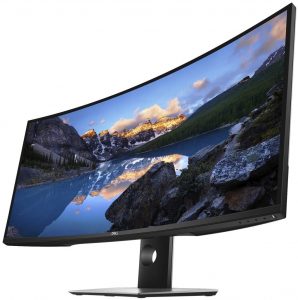
The best ultra-wide office monitor we’ve reviewed so far is the Dell U3818DW. This 38-inch high-resolution monitor is perfect for multitasking because there’s ample scope for several windows to be opened side-by-side. This is subtly curved, which helps improve visibility on the sides of the frame, and it has an IPS display that allows large viewing angles, and the picture is correct no matter how close you are sitting.
This monitor is better used in a medium-light room. This handles the reflections very well, but it can’t be light enough to remove the glare. The color accuracy is outstanding out of the box and has excellent gradient efficiency, but unfortunately, there is no support for HDR.
Response time is good, and the input lag is low, but if you’re trying to play on this display, it has a 60Hz screen and doesn’t support any variable refresh rate technology. Another fantastic function for multitaskers is its image-by-picture mode, which lets you view two sources simultaneously.
Unfortunately, the darkroom performance is not the best due to its poor contrast ratio, while most IPS panels are supposed to do just that. However, it has four USB 3.0 ports, a USB-C connection, built-in microphones, and a flash-free backlight. Overall, if you’re searching for an ultra-wide office monitor that will help you be more successful, this one is a really good choice.
- The image remains accurate when viewed at an angle
- Excellent out of the box accuracy
- Lots of screen real-estate great for multitasking
- Noticeable motion smearing caused by overshoot
- Blacks appear gray in a dark room
6. BETTER GAMING ALTERNATIVE: LG 34GN850-B
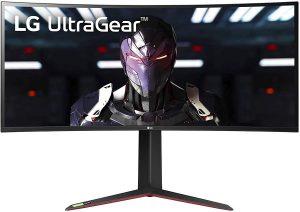
When you’re searching for an ultra-wide with improved gaming efficiency than the Dell U3818DW, try out the LG 34GN850-B. This has a smaller 34-inch screen size, but it has a maximum resolution of 1440p and a refresh rate of 160Hz.
The response time is slightly higher, and there is much less motion blur in fast-moving scenes. It natively supports FreeSync to reduce visual clutter and has been certified to be compatible with the latest NVIDIA graphics cards as well.
In fact, it embraces HDR and has fairly good experience for it. Unfortunately, the viewing angles are not as strong as the Dell’s, and there is no swivel switch to the stand. However, this device does not have a USB-C connector but does not have a Picture-in-Picture mode for multitasking.
Generally, if you’re just using a monitor for work, Dell is a safer option because it has more screen property and multitasking features. However, if you have a gaming goal, then the LG is the best choice.
- Superb response time.
- Great out-of-the-box color accuracy.
- Exceptionally low input lag.
- Sub-par contrast ratio.
- Poor ergonomics.
7. Best Budget Monitor: ASUS VG278QR
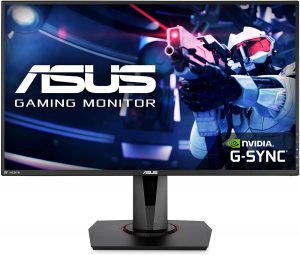
The best budget monitor we’ve reviewed thus far is the ASUS VG278QR. It’s a good 165Hz, 1080p monitor with fantastic low-cost gaming performance and a perfect pick for office usage as well.
This has very wide viewing angles for the IPS panel, which is perfect if you choose to share your screen with anyone. It can get bright enough to battle the glare in almost any room, and it has good reflective handling. This has outstanding color accuracy, and unless you need incredibly precise colors, you won’t need to have this adjusted.
This display has an outstanding response time at its highest refresh rate, with almost no motion blur behind fast-moving objects. It always has a decent answer at 60Hz, but there’s a little of motion blur. This has FreeSync native software for a tear-free gaming experience.
Unfortunately, it has a mediocre native contrast and a disappointing black uniformity, which is expected from the IPS display, so it is not suitable for dark room viewing. Fortunately, it has built-in speakers, and if you decide to watch videos on it, you don’t need an additional system. Overall, you can’t go wrong with this monitor because of its size, making it the best budget monitor.
- Fantastic motion handling.
- Outstanding color accuracy out of the box.
- Great gaming features, including FreeSync support.
- Limited 1080p resolution.
- Mediocre dark room performance.
8. CHEAPER ALTERNATIVE: VIEWSONIC XG2402
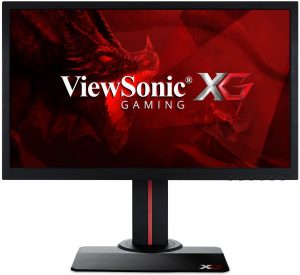
When you are looking for a gaming console in the budget range, the ViewSonic XG2402 is a decent option. The image quality of the ASUS VG279Q is higher, but the ViewSonic is still a good overall display that works best as a gaming monitor.
It has a regular 144Hz refresh rate and embraces FreeSync VRR technology to provide a nearly tear-free gaming experience. It has an excellent reaction time, which results in very little motion blur, and the input latency is exceptionally low.
It’s a flicker-free display, but some gamers might be frustrated with the lack of a BFI feature. Unfortunately, it uses a TN screen, so the contrast ratio and viewing angles are still quite frustrating, but it has excellent out-of-the-box color accuracy.
If you’re looking for the best budget monitor, the ASUS is a great choice, but if you want a gaming budget monitor, the ViewSonic is a good alternative.
- Great gaming performance, with FreeSync support and a 144 Hz refresh rate
- Excellent fast response time with low motion blur
- Poor dark room performance
- Disappointing viewing angle
FAQs
Should I choose an IPS, TN, or VA panel for color accuracy?
IPS panels generally offer the best color accuracy and wide viewing angles. While TN and VA panels can also provide decent color accuracy, they may have more limitations in viewing angles and contrast ratios.
Is HDR important in a monitor?
HDR (High Dynamic Range) can enhance the visual experience by providing a wider range of colors and improved contrast. However, the effectiveness of HDR can vary among monitors, and not all content is optimized for HDR. Consider your specific needs and prioritize other features if HDR is not a priority.
Can I connect multiple monitors to my computer?
Yes, most modern graphics cards support multiple monitor setups. You can connect multiple monitors using the available display outputs (HDMI, DisplayPort, DVI) on your graphics card and configure them in your computer’s display settings.
What is the benefit of a curved monitor?
Curved monitors provide a more immersive viewing experience by wrapping the display around your field of vision. They can reduce eye strain by minimizing distortion and maintaining consistent viewing distances across the screen. Curved monitors can be particularly beneficial for gaming and multimedia consumption, offering a wider field of view and enhancing depth perception.
Is it important to calibrate a monitor?
Calibration is important to ensure accurate and consistent color reproduction on your monitor. A properly calibrated monitor displays colors as they were intended, making it crucial for tasks such as photo editing, graphic design, and content creation. Calibration tools and software can help adjust settings like brightness, contrast, color temperature, and gamma to achieve optimal results.
Can I use a monitor with my laptop?
Yes, you can use a monitor with your laptop to extend your screen real estate or mirror your laptop’s display. Most laptops have video output ports (such as HDMI, DisplayPort, or VGA) that allow you to connect an external monitor. Simply connect the monitor to your laptop using the appropriate cable, and adjust the display settings in your operating system to configure the setup.
Final Thought
Our recommendations are based on what we think are the best computer monitors currently available. They are adapted to be valid for most people, in each price range. Rating is based on our review, factoring in price, and feedback from our visitors.


